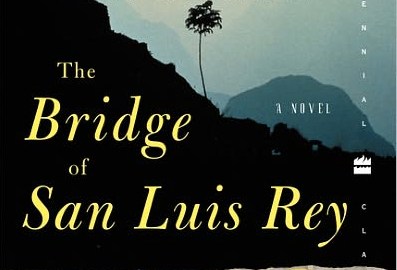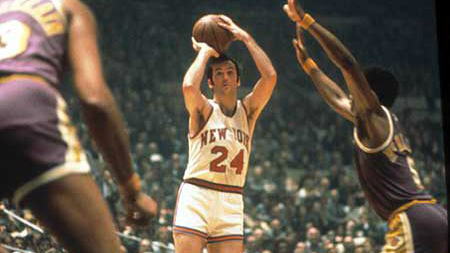Is Thornton Wilder God?

People are not talking enough about The Bridge of San Luis Rey. No question, it’s a well-respected novel: it won the Pulitzer in 1928 and came in at #37 on the MLA’s list of “100 Best Novels of the Twentieth Century.” It was adapted, apparently, into a 2004 Robert De Niro film, and it had a brief turn in the historical spotlight when Tony Blair quoted it in his 9/11 memorial speech. All well and good—but where is the buzz, where is the chatter? Who has nudged you lately, at your water cooler or watering hole, to ask: “Have you read Thornton Wilder’s prose masterpiece, The Bridge of San Luis Rey?”
Well, have you? It’s outstanding. As pure prose lyricism it ranks with anything by Nabokov or Cather or Fitzgerald. Actually it may owe a debt to Fitzgerald; it debuted two years after Gatsby and sustains something of the same tone of ironic elegy. Other influences it flaunts more openly: one of its characters is based on the life and letters of Madame de Sévigné, while its prose samples the baroque flavor of the Spanish Golden Age plays to which it makes frequent and loving allusion. But if the cords that bind it to other works are easy enough to trace, Bridge is simultaneously its own world: small, exotic, and realized to perfection.
The story is so simple that it’s often called a fable. In 1714 a rope bridge collapses in Peru, plunging five travelers into a ravine. The single witness, a monk named Brother Juniper, decides to investigate who they were, why they were crossing the bridge, and whether their deaths conform to a divine plan. Such answers as he finds you find along with him, though you learn more than he’s ever permitted to know.
The book is dense with moral wisdom, but it’s the style and not the substance that I really love. E. B. White once called Walden “a collection of certified sentences”; Bridge is stamped with the same seal of quality from start to finish. You can open it at random and scoop up gems:
There was something in Lima that was wrapped up in yards of violet satin from which protruded a great dropsical head and two pearly hands; and that was its archbishop.
Wilder relished such syntactical surprises; earlier on the same page there is this:
To Uncle Pio nothing else mattered. What was there in the world more lovely than a beautiful woman doing justice to a Spanish masterpiece?—a performance (he asks you), packed with observation, in which the very spacing of the words revealed a comment on life and on the text…
How perfect (I ask you) is that parenthetical? So excited is Uncle Pio by the actress he’s coaching, so uncontainable his passion for the theater, that he breaks the fourth wall and addresses us, with Wilder as medium, across the centuries.
Wilder’s own love of theater is everywhere apparent in the novel. He writes in scenes, in set-pieces; he salts tragedy with comedy and vice versa; he is not afraid to orchestrate dramatic exits and entrances, secret rendezvous and portentous messages, business with children and animals:
The children who had been playing by the fountain stared at her for a moment, and went away alarmed, but a llama (a lady with a long neck and sweet shallow eyes, burdened down by a fur cape too heavy for her and picking her way delicately down an interminable staircase) came over and offered her a velvet cleft nose to stroke. The llama is deeply interested in the men about her, is even fond of pretending that she too is one of them and of inserting her head into their conversations as though in a moment she would lift her voice and contribute a wan and helpful comment. Soon Doña María was surrounded by a number of these sisters who seemed on the point of asking her why she clapped her hands so and how much her veiling cost a yard.
Doña María had arranged that any letters arriving from Spain should be brought to her at once by a special messenger. She had travelled slowly from Lima and even now as she sat in the square a boy from her farm ran up and put into her hand a large packet wrapped in parchment and dangling some nuggets of sealing-wax. Slowly she undid the wrappings. With measured stoic gestures she read first an affectionate and jocose note from her son-in-law; then her daughter’s letter. It was full of wounding remarks rather brilliantly said, perhaps said for the sheer virtuosity of giving pain neatly. Each of its phrases found its way through the eyes of the Marquesa, then, carefully wrapped in understanding and forgiveness it sank into her heart. At last she arose, gently dispersed the sympathetic llamas, and with a grave face returned to the shrine.
When the curtain drops, all this stagecraft leaves us delighted but a little chilled. We realize that Brother Juniper’s search has led us, in a sense, to the author; Wilder himself has been the invisible Stage Manager shepherding the five travelers to their deaths. If we take from the book any notion of a literal God, it’ll have to look a lot like Thornton Wilder: detached, ironic, amused by our theodicies, unwilling to offer any consolation but the splendor of the created world. Or else, willing only to offer consolations as baffling as our misfortunes—the llama’s ungainly grace, approaching us and vanishing.
Though I don’t finish Bridge believing in a “divinity that shapes our ends,” I do find a strange kind of sanctity in the book itself. This seems to be a common response to Wilder’s fiction. In an interview with the Library of America blog last December, J. D. McClatchy remarked:
Wilder remains a writer whom readers approach, I think, on their own. He is discovered more than he is taught. In that he resembles the great experiences of life—sex and love and ambition and heartbreak. Readers encounter the novels of Wilder more often by chance than by assignment, and the result is a more private, personal experience, as if they alone understand. We don’t experience Hemingway, Fitzgerald, or Faulkner like that, since we encounter their work publicly, in class. They’re the ABCs of American fiction. When you discover Wilder it’s as if you’ve found a new letter. I wouldn’t put Wilder ahead of those others, but he’s part of the alphabet.
This was very much my own experience, but McClatchy’s haste to put Wilder in his place makes me wonder. Hemingway’s novelistic project was more ambitious, his style more original and influential than Wilder’s, but did he ever write a hundred pages as perfect as The Bridge of San Luis Rey? If not, is he self-evidently greater? Should externalities like ambition and influence sway our judgment of achievement itself? Precisely because so many critics seem to think so, Wilder is a novelist who demands to be read rather than ranked. Do him that justice if you haven’t already: start with Bridge, which you can polish off in two sittings and which will disproportionately repay your time. When you’re finished, nudge someone.
[Image: Harper Perennial Classics edition, The Bridge of San Luis Rey. Courtesy Barnes & Noble.]




